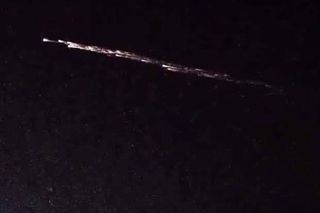
A giant piece of a recently launched Chinese rocket fell to Earth last night (July 27), blazing a spectacular sky trail that left observers across parts of the western United States slack-jawed.
The dazzling fireball, which you can see in this awesome video by observer Matt Holt, lit up skies over Utah, Nevada, Colorado, Idaho and California about 9:40 p.m. local time Wednesday (12:40 a.m. EDT and 0440 GMT today, July 28), breaking into many bright pieces as it went.
The sky show occurred around the peak of the annual Delta Aquarid meteor shower, but it wasn't caused by bits of comet dust. Rather, experts say, the culprit was the second stage of China's Long March 7 rocket, which launched on its maiden flight June 25.
The 6-ton rocket stage hit Earth's atmosphere at about 18,000 mph (29,000 km/h), said astronomer Jonathan McDowell of the Harvard-Smithsonian Center for Astrophysics, also an assiduous satellite tracker.
"Only bigger re-entry so far this year was a Russian Zenit rocket stage that came down over Vietnam on New Year's Day," he said in another tweet.
China developed the Long March 7 in part to help build the space station it wants to have up and running by the early 2020s. On June 25 — the rocket's first flight — the Long March 7 lofted a prototype crew capsule and a variety of technology demonstrations, Chinese officials have said.
The Long March 7 initially launched to an orbit that took it as close to Earth as 126 miles (203 km), and as far away as 235 miles (378 km). By yesterday morning, friction with Earth's atmosphere had reduced that orbit to 81 miles by 89 miles (131 km by 144 km), McDowell tweeted.
Sign up for the Live Science daily newsletter now
Get the world’s most fascinating discoveries delivered straight to your inbox.
And then came the spectacular fall.
Follow Mike Wall on Twitter @michaeldwall and Google+. Follow us @Spacedotcom, Facebook or Google+. Originally published on Space.com.


